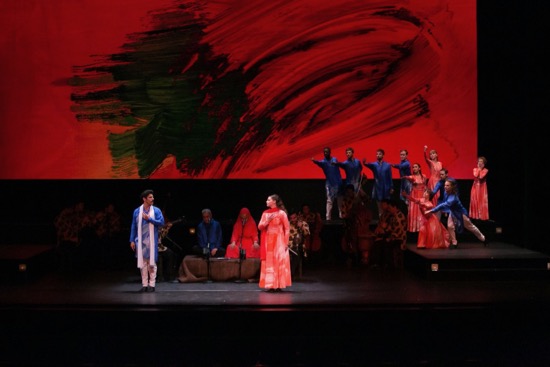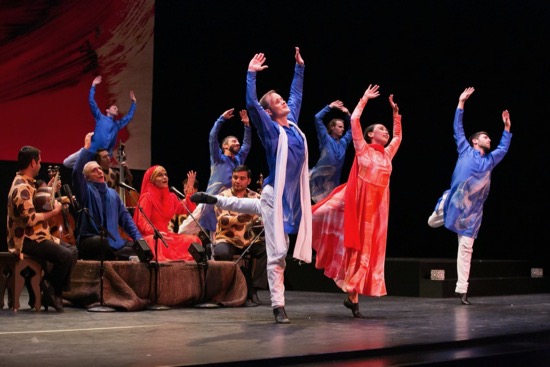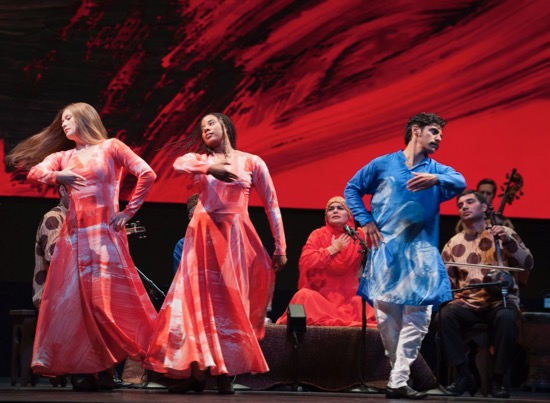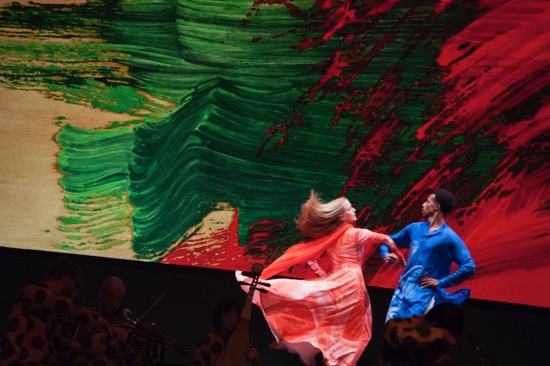The White Light Festival presents Layla and Majnun, directed and choreographed by Mark Morris.

Mark Morris Dance Group in Layla and Majnum. (Center): Domingo Estrada, Jr. and Nicole Sabella. (R, forground): Noah Vinson and Billy Smith restrain Christine Sahaida. Men at back (L to R): Brandon Randolph, Sam Black, Brian Lawson, Dallas McMurray. (In front of them, L to R): Mica Bernas, Lesley Garrison, and Lauren Grant. Photo: Beowulf Sheehan
How many poets have compared love to a flame and passion to a consuming fire— love that can obsess you, drive you mad? In the ancient tale of Layla and Majnun, the hero was born with another name; “majnun” labels him as one losing his mind over love for Layla, and, ironically it is that madness that renders him an unsuitable husband for her, who, against her own wishes, is married to another.
This story of a burning love became a poem by Muhammad Fuzuli (1483-1556), which became the libretto for an opera by the Azibaijani composer Uzeyir Hajibeyli (1885-1948) that premiered in Baku in 1908. A hundred years later, violinists Johnny Gandelsman and Colin Jacobsen of Yo-Yo Ma’s Silk Road Ensemble collaborated with the great Azerbaijani singer Alim Qasimov to transform the opera into a chamber piece. In 2016, Mark Morris added dancing to it—not incidental dancing, but movement deeply embedded in the music and the story.
For Layla and Majnum’s performance in the Rose Theater as part of Lincoln Center’s White Lights Festival, the collaborators wisely chose to tune up our ears with a medley that the program describes as “pieces based on the melodic patterns of Bayati Shiraz, which is one of the major mughams of Azerbaijani music.” A mugham is both modal, following strict rules, and improvisational. The two singers, Kamila Nabiyeva and Miralam Miralamov, sit on a low platform, flanked by Zaki Valiyev and Rauf Islamov. Valiyev plays the tar, a long-necked, plucked instrument held horizontally across his chest; Islamov’s kamanche, a bowed instrument, stands vertically on his lap. The voices of the singers and their gestures convey freedom contending with pressure. Miramalov’s tenor can ring out or roughen slightly. Nabiyeva’s soprano conveys shades of regret and questions to heaven. They take turns, banter, reproach unseen others.
We have ample time too to survey Howard Hodgkin’s remarkable scenic design. The backdrop (entitled “Love and Death”) shows a great wave of red paint that looks as if a huge broom had swept it to one side, where it seems to overpower an emerald green swipe. James F. Ingalls’ lighting design can subtly tint the more neutral areas of the rectangle. Raised platforms on either side of the stage ascend step by step to a high, narrower one that spans the stage at the back; a central staircase also leads up to it. The setting may be intended to let us feel that this concert is happening in a family’s home. When Layla and Majnun begins, members of a string quintet, a percussionist, a pipa player, and one who plays a shakuhachi sit in a shallow semi-circle behind the center-front area, where Valiyev and Islamov are joined by Qasimov, who will sing Majnun’s feelings and Fargana Qasimova (his daughter) who will channel Layla.

Layla and Majnum. (Foreground, L to R): Dallas McMurray and Mica Bernas. Musicians (L to R): Zaki Valiyev, Alim Qasimov, Fargana Qasimova, Rauf Islamov. Men behind them ( to R): Noah Vinson, Brian Lawson, Billy Smith, and Sam Black. Photo: Beowulf Sheehan
The dancers travel around this symmetrical maze. They dance on every level of the platforms as well as on the stage floor, both in front of the four leading musicians and between them and the other instrumentalists. The costumes, designed by Hodgkins and realized by Maile Okamura, help us keep track of the men and women, and how they mingle or don’t. The women’s long-sleeved, high-necked, full-skirted dresses may be plain in cut, but they’re a vibrant, mottled orange; the long, lightweight shirts that the men wear over black pants are a vivid blue. Seldom does anyone leave the stage. When not dancing, they watch, seem to converse, hurry to new positions. But they also create formal designs—reclining, say, in identical positions, sitting cross-legged to move their arms in synchrony.
As a very young man, Morris performed in Seattle’s Koleda Folk Ensemble. He studied flamenco in Spain. His respect for a variety of dance styles is well known, and, while the movement he created for Layla and Majnun, does not (as far as I know) borrow steps from Azerbaijan—a republic bordered by Georgia, Russia, Armenia, Iran, and the Caspian Sea—it hints at traditions. The women wear their hair loose, and when they spin in a manner that subtly evokes Sufis, it’s not only their skirts that fly out. Their torsos get into the act, too, bending, opening to the sky. Men and women often pair busy feet with sometimes sinuous bodies, stamping softly, crossing one foot over the other, kicking a leg out. Even something that could be taken for an arabesque creates a image of a person pulled in two directions at once.
Morris has had some brilliant ideas in terms of formalizing this extremely dramatic tale of impossible love. In order to suggest a ritual performance, various of the dancers pass and rearrange the eight small, flickering lamps that initially stud the stage. And he presents “Majnun” and “Layla” as roles that any of the dancers can assume. When you see a man with a white scarf, that’s the hero; the heroine wears a slim red one.

Layla and Majnun. (L to R): Rita Donohue, Michelle Yard (original cast), and Domingo Estrada, Jr. Seen behind them: Fargana Qasimova and Rauf Islamov. Photo: Susana Millman
In Act I: “Love and Separation,” Dallas McMurray and Mica Bernas reflect the anguished sung words that bespeak the pair’s need to be together: “My true love knows my heart is breaking. . . .He knows every sliver of sorrow in my heart” (we see some of the text projected above the proscenium arch). They don’t touch, but his curving arms define a space in which she swirls, as if sensing an embrace despite the air between them.
With equal ardor, Nicole Sabella and Domingo Estrada, Jr. slip into the lovers’ roles in Act II: “The Parents’ Disapproval.” Now the singers’ voices plead and apologize, and other dancers emerge briefly from the group to suggest that disapproval: Christina Sahaida and Billy Smith as Majnun’s parents, Lauren Grant and Noah Vinson as Layla’s. The focus, however, is on Sabella and Estrada and their passion. Confronting Sahaida, Estrada dances impetuously and hinges backward as if love itself is pushing him down. When he reaches out to touch Sabella’s face, Grant pulls her away.
And all this time, no one is absolutely still or silent for long. The dancers who represent family or friends intermittently rush about—regrouping, pairing up by gender, dancing. The plot is moving along. Act III: “Sorrow and Despair” begins with windy, mournful notes on the Japanese shakuhachi. Now Estrada and Sabella have divested themselves of their roles, and Laurel Lynch and Aaron Loux have assumed them. Qasimov and Qasimova’s voices tremble and cry out as the lovers try to resign themselves. “I need to feel this sorrow as long as I live,” says Majnun; “I need this sorrow because this sorrow needs me.” Loux walks along the line of slumbering men, rousing each as he goes; Lynch does the same with the women. Leaping together, meeting and parting, they want to be heard.

Lesley Garrison and Durell R. Comedy in Layla and Majnun. Photo: Susan Millman
A lively dance ushers in Act IV: “Layla’s Unwanted Wedding.” Grant and Vinson are handing her over to Durell R. Comedy. While the true lovers have barely touched, the approved husband pulls the reluctant Layla (now Lesley Garrison) away from Majnun (Sam Black), who is berating her for breaking her vow to him. It’s a shock when Comedy lifts her to show that he possesses her.
In the final Act V: “The Lovers’ Demise,” the singers present their different understanding of what happened to them—Layla feeling that Majnun forgot their vows, he feeling that, although they would like to be together, “separation brings them joy forever.” Morris lets us see each of the four women who became Layla gradually joining one another just before the final drama happens in the center of the high horizontal platform. Vinson and Smith hold Bernas and McMurray apart, and Grant and Sahaida rush up the steps just in time to help catch their children as each falls backward into parental arms. You catch your breath.
In some versions of the story, Majnun becomes a hermit, and Layla remains the wife of a man she doesn’t love, yet they never forget their adoration of each other. And Morris, perhaps also influenced by patterns in the music, refrains from a Romeo-and-Juliet ending. Beginning with McMurray, each of those who played Majnun performs a short solo on the stage-right platform; each is different, individual, compelling. Then all slumber until a low bass note awakens them, while the two singers and two musicians in the center seem to sleep. Each pair of lovers meets, touches, and exits. The string players make soft music. Dare I mention paradise?
